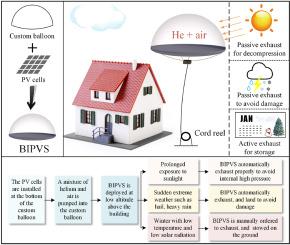A portable balloon integrated photovoltaic system deployed at low altitude
IF 9
1区 工程技术
Q1 ENERGY & FUELS
引用次数: 0
Abstract
This paper proposed a portable balloon-integrated photovoltaic system (BIPVS) deployed at low altitude. The inflatable and deflatable design enhances the proposed system flexibility and mobility, enabling it have a wider range of application scenarios. Case studies were conducted based on cities' data of Vasteras, Vancouver, New York, Shanghai and Hong Kong to evaluate 10,000 BIPVS's annual power generation potential. Mid-to-high latitudes are not suitable for photovoltaic power generation in winter due to snow and ice coverage. Excluding the unsuitable winter months, simulation results show that the average monthly power generation of the BIPVSs amounts to 3.921 GWh, 4.238 GWh, 4.275 GWh, 3.337 GWh, and 3.379 GWh, respectively, during the effective working months within a year, which shows the superior performance of mid-to-high latitudes over their low latitudes. Over the life cycle, the BIPVSs exhibit a cumulative power generation capacity, amounting to 479.492 GWh, 592.18 GWh, 672.105 GWh, 641.155 GWh, and 708.334 GWh, respectively, and their total profits are 79.614 million USD, 37.007 million USD, 75.146 million USD, 12.946 million USD, 107.369 million USD, accompanied by the return on investment of 218.6 %, 101.6 %, 206.3 %, 35.5 %, 294.8 %, respectively. These findings illustrate the significant energy and economic advantages and potential of BIPVS.

低空部署的便携式气球集成光伏系统
本文提出了一种可在低空部署的便携式气球集成光伏系统(BIPVS)。充气和放气设计增强了系统的灵活性和机动性,使其具有更广泛的应用场景。根据瓦斯塔斯、温哥华、纽约、上海和香港等城市的数据进行了案例研究,以评估 10,000 个 BIPVS 的年发电量潜力。由于冰雪覆盖,中高纬度地区冬季不适合光伏发电。剔除不适宜的冬季月份,模拟结果显示,在一年内的有效工作月份,BIPVS 的月平均发电量分别为 3.921 千兆瓦时、4.238 千兆瓦时、4.275 千兆瓦时、3.337 千兆瓦时和 3.379 千兆瓦时,这表明中高纬度地区的性能优于低纬度地区。在整个生命周期内,BIPVS 的累计发电量分别为 479.492 GWh、592.18 GWh、672.105 GWh、641.155 GWh 和 708.334 GWh,总利润分别为 79.6.14亿美元、3700.7万美元、7514.6万美元、1294.6万美元、10736.9万美元,投资回报率分别为218.6%、101.6%、206.3%、35.5%、294.8%。这些结果说明了 BIPVS 在能源和经济方面的巨大优势和潜力。
本文章由计算机程序翻译,如有差异,请以英文原文为准。
求助全文
约1分钟内获得全文
求助全文
来源期刊

Energy
工程技术-能源与燃料
CiteScore
15.30
自引率
14.40%
发文量
0
审稿时长
14.2 weeks
期刊介绍:
Energy is a multidisciplinary, international journal that publishes research and analysis in the field of energy engineering. Our aim is to become a leading peer-reviewed platform and a trusted source of information for energy-related topics.
The journal covers a range of areas including mechanical engineering, thermal sciences, and energy analysis. We are particularly interested in research on energy modelling, prediction, integrated energy systems, planning, and management.
Additionally, we welcome papers on energy conservation, efficiency, biomass and bioenergy, renewable energy, electricity supply and demand, energy storage, buildings, and economic and policy issues. These topics should align with our broader multidisciplinary focus.
 求助内容:
求助内容: 应助结果提醒方式:
应助结果提醒方式:


